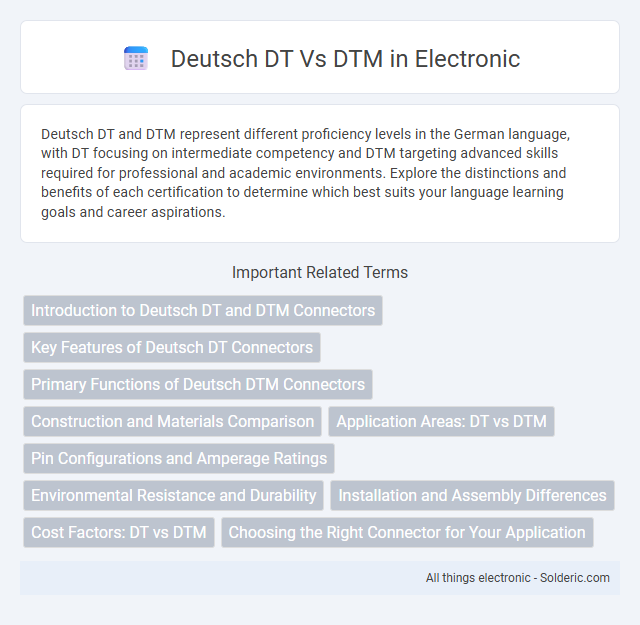Deutsch DT and DTM represent different proficiency levels in the German language, with DT focusing on intermediate competency and DTM targeting advanced skills required for professional and academic environments. Explore the distinctions and benefits of each certification to determine which best suits your language learning goals and career aspirations.
Comparison Table
| Feature | Deutsch DT | Deutsch DTM |
|---|---|---|
| Connector Type | Standard sealed connector | Sealed connector with metal shell |
| Durability | Good environmental protection | Enhanced durability and shielding |
| Application | General automotive and industrial use | High vibration and harsh environment applications |
| Pin Count | Up to 12 contacts | Up to 12 contacts |
| Sealing | IP67 rated | IP68 rated |
| Material | Plastic housing | Metal housing for EMI protection |
Introduction to Deutsch DT and DTM Connectors
Deutsch DT connectors provide reliable power and signal connections in harsh environments, featuring easy assembly and robust sealing for automotive and industrial applications. DTM connectors offer a more compact design with high-density terminals, suitable for limited-space areas requiring secure electrical connections and quick mating. Both connector series use proven Deutsch technology to ensure durability, environmental protection, and consistent performance under vibration and moisture exposure.
Key Features of Deutsch DT Connectors
Deutsch DT connectors feature a rugged, sealed design ideal for harsh environments, offering reliable electrical performance with corrosion-resistant contacts. They include a secure latch mechanism, multiple circuit sizes from 2 to 12 pins, and a compact, lightweight shell made from durable thermoplastic materials. These connectors provide excellent resistance to vibration, moisture, and chemicals, making them suitable for automotive, industrial, and heavy equipment applications.
Primary Functions of Deutsch DTM Connectors
Deutsch DTM connectors are designed primarily for automotive and industrial applications, offering reliable secondary locking and waterproof sealing for wiring harnesses. They provide a secure, vibration-resistant connection for medium-duty environments, ensuring your electrical systems maintain integrity under harsh conditions. With multiple cavity options and color-coded plugs, these connectors simplify installation and maintenance across diverse applications.
Construction and Materials Comparison
Deutsch DT connectors feature a rugged design with environmentally sealed aluminum shells and gold-plated copper alloy contacts, ensuring durability and corrosion resistance in harsh conditions. The Deutsch DTM series offers a more compact construction using thermoplastic housings and tin-plated contacts, optimized for lighter assembly and space-constrained applications. Your choice depends on whether you prioritize heavy-duty robustness (DT) or lightweight, compact efficiency (DTM) in connector materials and build.
Application Areas: DT vs DTM
Digital Twins (DT) are widely applied in dynamic simulation, predictive maintenance, and real-time system monitoring across manufacturing, automotive, and aerospace industries. Digital Twin Models (DTM), representing detailed virtual replicas, are primarily used in design validation, performance optimization, and scenario analysis within engineering and construction sectors. DT focuses on operational data integration for continuous process improvement, while DTM emphasizes high-fidelity modeling for strategic decision-making and system development.
Pin Configurations and Amperage Ratings
Deutsch DT connectors feature a 2-12 pin configuration with a rated current of up to 13 amps, designed for rugged automotive and industrial applications. Deutsch DTM connectors support 2-6 pins and have a lower amperage rating, typically up to 7.5 amps, making them ideal for lighter duty electrical systems. You should choose DT connectors for higher current demands and DTM connectors when space and lower amperage are key considerations.
Environmental Resistance and Durability
Deutsch DT connectors offer robust environmental resistance with high ingress protection ratings, making them suitable for harsh conditions such as moisture and dust exposure. DTM connectors provide enhanced durability through smaller, lightweight designs optimized for limited-space applications without compromising on sealing and corrosion resistance. Choosing between DT and DTM depends on your specific needs for environmental toughness and long-term connector performance.
Installation and Assembly Differences
Deutsch DT connectors feature a straightforward installation process with a simple clamping mechanism and are designed for quick assembly in automotive and industrial applications. Deutsch DTM connectors require a more detailed assembly procedure, including the use of special tooling for secure terminal insertion and higher-density connector assembly. DT connectors are generally larger and easier to assemble by hand, while DTM connectors prioritize compactness and precise alignment during installation.
Cost Factors: DT vs DTM
Deutsch DT connectors typically offer a more cost-effective solution compared to Deutsch DTM connectors due to their simpler design and fewer contact points. The DT series is optimized for applications requiring 2 to 12 pins, making it suitable for less complex wiring harnesses, which reduces material and manufacturing costs. In contrast, DTM connectors, designed for more demanding automotive and industrial environments with smaller contact spacing and 2 to 12 pins, incur higher costs due to enhanced sealing, durability, and precision engineering.
Choosing the Right Connector for Your Application
Selecting between Deutsch DT and DTM connectors depends on application requirements such as size, environmental protection, and electrical needs. Deutsch DT connectors offer larger contact sizes and higher current ratings, ideal for heavy-duty applications exposed to harsh environments. Conversely, DTM connectors provide a more compact design with superior sealing, making them suitable for space-constrained applications requiring excellent moisture and dust resistance.
Deutsch DT vs DTM Infographic

 solderic.com
solderic.com